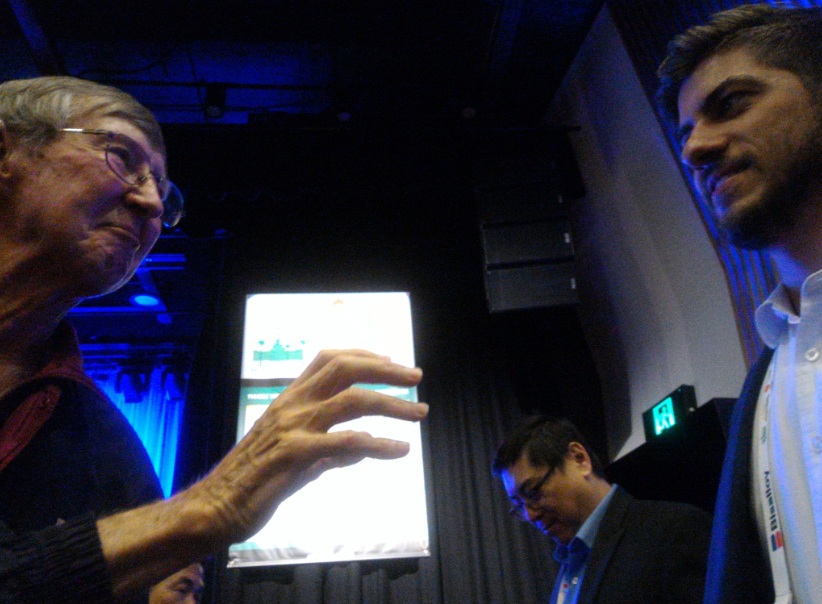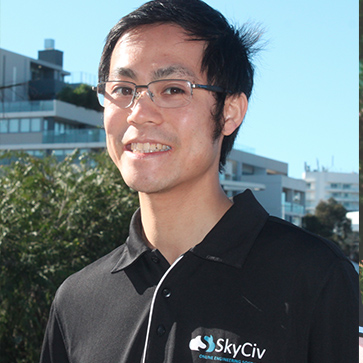 "I’m a member of the generation of structural engineers who were the same age as you when computers first came out. And we were doing exactly what you’re doing, and the traditional software you’re now talking about, that you’re sort is going beyond, actually arose from some of those people who made a special effort, like you’re doing, to make the results available for everybody."
-George Walker, Structural Engineer
Presenting in front of an auditorium of professional structural engineers, Sam fielded a number of questions about SkyCiv. A transcipt of the question and answer session follows.
Question: Is there some standardized output format that you could get off the website? I mean record keeping is important, for instance in 10 years’ time users might want to go back and revisit their analysis or results, do you cater for this?
Answer: Good question, we do have record keeping documents in place. Following the analysis, you can actually custom produce a report that completely analyses the structure and also tells you the inputs and all the information that’s gone through, with date stamps and the software version you’ve used. It tracks every step of the process. We’re making sure you have a well documented set up and analysis so you can track anything moving forward. You can keep it on your computer or print it out.
Question: My question is on the liability you take on by providing the software. Have you looked into any legal risks you might expose yourself to by people relying on your software if perhaps there is a bug or mistake in the software which you are not aware of at the time that they use it?
Answer: So we did consult a lawyer and we went through that whole process and have insurances in place. We also put our software through rigorous testing with every update. We will check the values against literally millions of values between what the solver is producing and the known values. And we won’t release until it checks off 100%. But it’s really up to the user and as an engineer we never take the result to be the right answer. We’re always skeptical. A bit of duty of care on the engineers, but we do mitigate the risk as much as possible from our side.
Question: How do you validate the results that you’re getting from your software? The old adage is garbage in, garbage out. If you get a user who doesn’t put the right input data in, are there any safeguards within the software to prevent that happening, so they don’t get garbage out and go on to do whatever it is they’re going to do with it?
Answer: Yeah definitely, as I mentioned before we perform checks against validation cases comparing millions of values. However if a user puts garbage in, we’ve put systems in place to capture that. You’ll get warnings for things like this. We wanted to reduce the chance of users building their structures incorrectly and the time wasted when trying to find out what's wrong. So what we’ve concentrated on over the last few months is putting in better warning systems. If a user hits solve on a beam with a section millimetres thin, over a span of say 10 meters, we will warn you and ask “are you sure you have the units correct?”.
Question: Can I just add a comment son. You’ve got these various programs in place now. So in 5 years time, will you have be sitting back with your feet up raking it in? Where do you see yourself in 5 years time?
Answer: We’re really focused on growing an organic business. A lot of tech companies will follow the same process and timeline. That is to have an idea, get investors, scale up and then sell. We’re not necessarily following this approach. We don’t actually have any investment at the moment. We’re bootstrapping and are focused on growing an organic business. So we’d really love to see SkyCiv continue to develop into solutions for engineers facing problems, and continue to build software applications that work into our existing software platform to solve those needs.
Question: You mentioned the organization Fishburners that provided support to you. Can you just explain a bit more about what support they give?
Answer: So Fishburners is a coworking start up space where hundreds of software companies and entrepreneurs will go and rent a desk for a subsidized amount. It’s not for profit, so you’re surrounded by similar minded people and you can work in a creative space where you can develop this technology, speak to entrepreneurs who might be further ahead than you and learn a lot quicker than you would alone in a garage. They’ve actually just opened up an office here in Brisbane. Fishburners are really doing great things, so I’d recommend anyone interested in innovation or tech to go down and get involved in some of the events they hold and meeting the people that are driving this innovation in Australia. They put on events with really high up people that come down and share their knowledge. For us this really sped up our growth and put us in touch with some really good people.
"I’m a member of the generation of structural engineers who were the same age as you when computers first came out. And we were doing exactly what you’re doing, and the traditional software you’re now talking about, that you’re sort is going beyond, actually arose from some of those people who made a special effort, like you’re doing, to make the results available for everybody."
-George Walker, Structural Engineer
Presenting in front of an auditorium of professional structural engineers, Sam fielded a number of questions about SkyCiv. A transcipt of the question and answer session follows.
Question: Is there some standardized output format that you could get off the website? I mean record keeping is important, for instance in 10 years’ time users might want to go back and revisit their analysis or results, do you cater for this?
Answer: Good question, we do have record keeping documents in place. Following the analysis, you can actually custom produce a report that completely analyses the structure and also tells you the inputs and all the information that’s gone through, with date stamps and the software version you’ve used. It tracks every step of the process. We’re making sure you have a well documented set up and analysis so you can track anything moving forward. You can keep it on your computer or print it out.
Question: My question is on the liability you take on by providing the software. Have you looked into any legal risks you might expose yourself to by people relying on your software if perhaps there is a bug or mistake in the software which you are not aware of at the time that they use it?
Answer: So we did consult a lawyer and we went through that whole process and have insurances in place. We also put our software through rigorous testing with every update. We will check the values against literally millions of values between what the solver is producing and the known values. And we won’t release until it checks off 100%. But it’s really up to the user and as an engineer we never take the result to be the right answer. We’re always skeptical. A bit of duty of care on the engineers, but we do mitigate the risk as much as possible from our side.
Question: How do you validate the results that you’re getting from your software? The old adage is garbage in, garbage out. If you get a user who doesn’t put the right input data in, are there any safeguards within the software to prevent that happening, so they don’t get garbage out and go on to do whatever it is they’re going to do with it?
Answer: Yeah definitely, as I mentioned before we perform checks against validation cases comparing millions of values. However if a user puts garbage in, we’ve put systems in place to capture that. You’ll get warnings for things like this. We wanted to reduce the chance of users building their structures incorrectly and the time wasted when trying to find out what's wrong. So what we’ve concentrated on over the last few months is putting in better warning systems. If a user hits solve on a beam with a section millimetres thin, over a span of say 10 meters, we will warn you and ask “are you sure you have the units correct?”.
Question: Can I just add a comment son. You’ve got these various programs in place now. So in 5 years time, will you have be sitting back with your feet up raking it in? Where do you see yourself in 5 years time?
Answer: We’re really focused on growing an organic business. A lot of tech companies will follow the same process and timeline. That is to have an idea, get investors, scale up and then sell. We’re not necessarily following this approach. We don’t actually have any investment at the moment. We’re bootstrapping and are focused on growing an organic business. So we’d really love to see SkyCiv continue to develop into solutions for engineers facing problems, and continue to build software applications that work into our existing software platform to solve those needs.
Question: You mentioned the organization Fishburners that provided support to you. Can you just explain a bit more about what support they give?
Answer: So Fishburners is a coworking start up space where hundreds of software companies and entrepreneurs will go and rent a desk for a subsidized amount. It’s not for profit, so you’re surrounded by similar minded people and you can work in a creative space where you can develop this technology, speak to entrepreneurs who might be further ahead than you and learn a lot quicker than you would alone in a garage. They’ve actually just opened up an office here in Brisbane. Fishburners are really doing great things, so I’d recommend anyone interested in innovation or tech to go down and get involved in some of the events they hold and meeting the people that are driving this innovation in Australia. They put on events with really high up people that come down and share their knowledge. For us this really sped up our growth and put us in touch with some really good people.
William Kuang
Engineer and Software Developer
BEng Mechanical (Hons1)
LinkedIn
Engineer and Software Developer
BEng Mechanical (Hons1)



